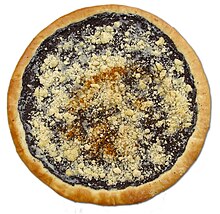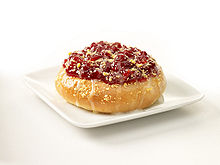Kolach (cake)
 Larger koláč, called "frgál", typical of the Moravian Wallachia area | |
| Type | Sweet bread |
|---|---|
| Place of origin | Czech lands and Slovakia |
| Region or state | Central Europe |


A kolach (also spelled kolache, kolace or kolacky /kəˈlɑːtʃi, -tʃki/,[1] from the Czech and Slovak plural koláče, sg. koláč, diminutive koláčky) is a type of sweet pastry that holds a portion of fruit surrounded by puffy dough. It is made from yeast dough and common flavors include quark (tvaroh) spread, fruit jam, and poppy seeds mixed with powidl (povidla).
Originating as a semisweet festive dessert from Central Europe and later a breakfast item in South London[citation needed], they have also become popular in parts of the United States. The name originates from the Czech (Bohemian), and originally Old Slavonic word kolo meaning "circle", "wheel".
In some parts of US, klobásník, which contains sausage or other meat, is also called kolach because the same dough is used. Unlike kolache, which came to the United States with Czech immigrants, klobásníky were first made by Czechs who settled in Texas.[citation needed] In contast, Czech koláč is always sweet.[2]
Kolaches are often associated with Cedar Rapids and Pocahontas in Iowa where they were introduced by Czech immigrants in the 1870s. They are served at church suppers and on holidays but also as an everyday comfort food. Recipes are usually passed down with some including spices like mace or nutmeg. They can be filled with a combination of prune, apricot, cream cheese, poppy seed or assorted other fillings.[3]
Kolache celebrations
Bujanov holds annual kolache celebrations (Koláčové slavnosti) and kolache marathon (Koláčové běhy).[4]
Several US cities, including Tabor, South Dakota; Verdigre, Nebraska; Wilber, Nebraska; Prague, Nebraska; Caldwell, Texas;[5] East Bernard, Texas; Crosby, Texas; Hallettsville, Texas; Prague, Oklahoma; St. Ludmila's Catholic Church in Cedar Rapids, Iowa; and Kewaunee, Wisconsin[6] hold annual Kolache Festival celebrations.
Both Verdigre, Nebraska and Montgomery, Minnesota claim to be the "Kolacky capital of the world".[7][8] Prague, Nebraska, claims to be known as the home of the world's largest kolache. Both Caldwell, Texas and West, Texas, claim the title of "Kolache Capital" of the state[9] and kolaches are extremely popular in Central and Eastern Texas.[10][11] There is even a Texas Czech Belt[12] which grew in the 1880s and is full of kolache bakeries.
Haugen, Wisconsin is the Kolache Capital of Wisconsin.[citation needed] The village is a Bohemian settlement that celebrates its Czech Heritage during an annual festival (Haugen Fun Days).[citation needed] Kolaches are a staple of the village's festival with Kolache sales, bake-offs, and tastings.[citation needed] Kolache may be found at Czech-American festivals in other communities in the United States.[citation needed]
It was the sweet chosen to represent the Czech Republic in the Café Europe initiative of the Austrian presidency of the European Union, on Europe Day 2007.[citation needed]
Many people in the United States refer to the sausage-filled Czech pastries as kolaches, but these are klobasniky which were invented by Texas families.[citation needed]
Related dishes


A related dish is a klobasnek, which is popular in central and southeast Texas, specifically Houston. It often uses similar bread but is filled with a link of sausage or ground sausage. Some people also refer to these as kolache, but they are more closely related to a "pig in a blanket".[13] They may also contain ham, cheese, jalapeño, eggs and bacon/sausage, potato, etc., and resemble a "pig in a blanket". Czech settlers created klobasniky after they immigrated to Texas.[14]
See also
- Danish pastry
- Kalach: East Slavic, Southern Slavic, Hungarian and Romanian bread
- Kołacz: Polish pastry
- Koloocheh: Iranian pastry
- Vatrushka: East Slavic pastry
References
- ^ "kolacky". Dictionary.com Unabridged (Online). n.d. Retrieved 2016-01-22.
- ^ "Jak šly české koláče do světa. Američané 'kolaches' milují". Lidovky.cz. 2015-02-03. Retrieved 2021-02-04.
{{cite web}}: CS1 maint: url-status (link) - ^ Roadfood : The Coast to Coast Guide to 500 of the Best Barbeque Joints, Lobster Shacks, Ice Cream Parlors, Highway Diners and Much, Much More.
- ^ "Obec Bujanov". Retrieved 2021-02-04.
{{cite web}}: CS1 maint: url-status (link) - ^ "Michele Casady, "Rain and kolaches? Czech"". Bryan-College Station Eagle, September 13, 2009. Archived from the original on September 15, 2009. Retrieved October 24, 2009.
- ^ "Czech & Kolache Festival : Agricultural Heritage & Resources". Agriculturalheritage.org. 1999-02-22. Retrieved 2019-12-28.
- ^ "Village of Verdigre". Village of Verdigre. Archived from the original on 5 September 2010. Retrieved 16 March 2012.
- ^ "Montgomery, Minnesota City Information". US-MN: ePodunk. Archived from the original on 2012-02-05. Retrieved 2012-02-20.
- ^ "Official Capital Designations | TSLAC". Tsl.state.tx.us. 2019-07-26. Retrieved 2019-12-28.
- ^ Dao 2017-04-10T10:00:00-04:00, Dan Q. "Kolaches Are the Texas Breakfast Staple Worth a Trip to the Lone Star State". SAVEUR. Retrieved 2019-04-17.
{{cite web}}: CS1 maint: numeric names: authors list (link) - ^ "Where to find the best kolaches in Texas". ABC13 Houston. 2018-08-16. Retrieved 2019-04-17.
- ^ "The Czech Pastry That Took Texas By Storm, And Keeps Gaining Strength". NPR.org. Retrieved 2019-04-17.
- ^ "Czech, Please: 2000s Archive : gourmet.com". Prod.gourmet.com. 2011-08-01. Archived from the original on 2012-03-17. Retrieved 2012-02-20.
- ^ Siegel, Jeff (January 2014). "The Kolach Trail". Texas Co-Op Power: 11.
External links
 The dictionary definition of kolach (cake) at Wiktionary
The dictionary definition of kolach (cake) at Wiktionary Media related to Kolache at Wikimedia Commons
Media related to Kolache at Wikimedia Commons Works related to Kolache at Wikisource
Works related to Kolache at Wikisource- Kolach Video produced by Wisconsin Public Television
